“Must-win” has become the most overused term in the NASCAR playoffs, to the point where it is used in cases where it simply isn’t true, as proven on Sunday at Kansas Speedway.
Entering the third and final race of the round of 12 of the NASCAR Cup Series playoffs at Kansas Speedway, the Hollywood Casino 400, four drivers were supposedly in “must-win” situations to advance to the round of 8.
All four of these drivers trailed Team Penske’s Joey Logano, the driver in the eighth and final transfer spot above the round of 8 cut line, by at least 18 points.
Hendrick Motorsports’ Alex Bowman trailed Logano by 18 points while teammate Chase Elliott trailed him by 22 points and teammate William Byron trailed him by 27 points. Stewart-Haas Racing’s Clint Bowyer trailed him by 24 points.
More from NASCAR Cup Series
- NASCAR Cup Series: New team set to compete in 2024
- NASCAR: Surprising name continuously linked to new seat
- NASCAR driver at risk of missing the Daytona 500?
- NASCAR set for rare appearance last seen 13 years ago
- NASCAR team adds third car, names driver for 2024 Daytona 500
Team Penske’s Brad Keselowski started this 267-lap race around the four-turn, 1.5-mile (2.414-kilometer) Kansas Speedway oval in Kansas City, Kansas just two points ahead of Logano in the playoff picture, putting him 20 points ahead of Bowman, 24 points ahead of Elliott, 26 points ahead of Bowyer and 29 points ahead of Byron.
Sure, overcoming these amounts is no easy task. But a “must-win”?
Joe Gibbs Racing’s Denny Hamlin ended up winning the race, even after locking up his round of 8 berth during the race itself. He won the race ahead of Elliott in second place.
Per the “must-win” theory, Elliott came up just shy of securing a round of 8 berth.
Yet the driver of the #9 Chevrolet did, in fact, clinch a spot in the round of 8 with his performance, as did Logano, as it was Keselowski dropped out.
So where did the “must-win” theory fail?
It didn’t fail; it simply wasn’t applicable to begin win, and for obvious reasons.
A total of 60 points are on the table in each race. For non-winners, the maximum point total available is 55 throughout an entire race. These 55 points include 10 points for winning stage one, 10 points for winning stage two and 35 points for finishing the race in second place.
Provided that at least 36 drivers compete in the race, which has been the case in each of the last 910 races going back to the 1993 season, the lowest possible point total for a driver is one, meaning that drivers can make up/lose 54 points compared to another driver in an individual race without actually winning.
So in what world does a 22-point deficit to the cut line — and a 24-point deficit to the driver two spots above that cut line — create a “must-win” situation?
It doesn’t.
But I guess it sounds more dramatic to say “Chase Elliott HAS TO WIN THIS RACE to keep his playoff hopes alive!” as Hamlin takes the white flag just tenths of a second ahead of him.
We want drama. We want comebacks. We want rallies. I get it.
But we also want truth.
That’s the whole reason for outlining the playoff scenarios entering this race to begin with. Look at the scenarios. Plug in numbers. Do the math.
And if you aren’t the kind to do that, just simply understand that 22 isn’t quite as big as 54.
Yes, Elliott did restart the race with two laps remaining below the round of 8 cut line. He advanced because of the positions that Keselowski lost. Based on the stage points that the two drivers scored throughout the race, Elliott needed to finish 14 positions ahead of Keselowski to advance to the round of 8. Keselowski ended up finishing in 19th place; a 15th place finish would have gotten him through, and he restarted the race in 13th with Elliott in third.
And yes, the odds that a specific driver actually makes up 54 points over another specific driver in a give race are infinitesimally small. But Elliott wasn’t 54 points behind the cut line. He was 22 points behind the cut line and 24 points behind the driver he ended up passing.
Neither scenario was a must-win scenario entering the race, and neither became one after stage two, which was a possibility considering a maximum of 20 stage points are on the table for each driver.
Winning is always the “simplest” way to advance from round to round in the NASCAR Cup Series playoffs. But so often situations in which drivers can advance on points are dubbed “must-win” situations simply because they seem insurmountable when they really aren’t. Sunday’s round of 12 finale at Kansas Speedway illustrated that it’s never over until it’s over.
